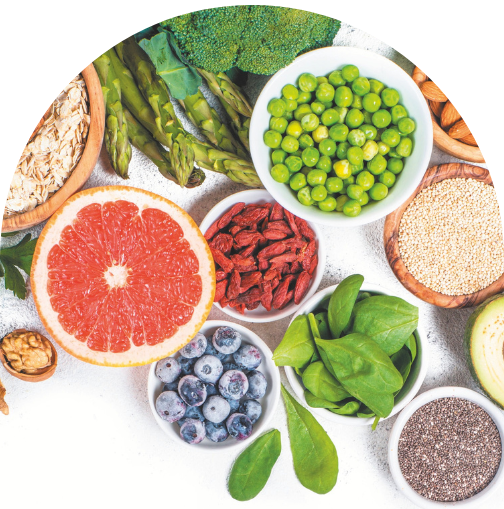Nutrition can be confusing. There is so much information out there, and much of it is flawed, misinterpreted, or flat-out false.
Why do nutrition myths exist?
Most myths relate to who is putting the nutrition information out there. Many writers or bloggers who write about nutrition do not have relevant educational and professional backgrounds. Unfortunately, the loudest voices aren’t always the most credible.
Myths can also come from the messages themselves and how we share them. The core elements of evidence-based nutrition are not appealing or seductive; for example, “eat your fruits and vegetables.” This statement might be erroneously re-written as, “cure [insert disease here] by eating [insert vegetable here].” Such a statement may lead to a myth about the “powers” of eating a certain vegetable.
Like in all fields of science, we continually learn more about nutrition through research. There is still a lot we don’t know about food and nutrition.
Rest assured that the information you get here is reliable. We are two board certified medical doctors with the highest level of available training in functional medicine. Keep reading to get our top recommendations and watch us BUST common nutrition myths.
How do we choose what to eat?
What we choose to eat is complex. Factors that affect what we eat include our tastes and preferences, our family’s tastes and preferences, cultural traditions, budgets, values, accessibility, convenience, time, social pressures, and yes, nutrition myths. There is no one way of eating that works for everyone because we are navigating all of these factors when we choose what to eat.
Some nutrition myths persist because of how some people draw on their personal experiences and the experiences of those around them. For example, if me and my friends try a diet and it works for all of us, then our human bias might lead us to believe that this diet works for everyone. We might want to share it on our Instagram pages in an attempt to help other people. While well-intentioned, this is a flawed way of interpreting nutrition science and sharing advice.
We should embrace the many reasons why we choose what to eat. However, we should leave nutrition myths out of this decision. Look to credentialed health professionals to separate myths from facts.
What are examples of common nutrition myths?
- Myth: Carbohydrates cause weight gain.
Fact: No one nutrient, food, or food group causes weight gain.
Weight gain is complex and cannot be attributed to just one food or food group. In general, weight gain will result when we consume calories over what our body needs to maintain body weight. However, other factors affect body weight too…and calories in/out is also not the answer to weight loss.
A diet for optimal health includes many foods with carbohydrates, which are our body’s preferred energy source. When it comes to carbohydrates, consider the quality. Choose carbohydrates that offer other nutrients, including fiber, vitamins, and minerals. Complex carbohydrates with fiber digest and absorb more slowly than simple carbohydrates… they also can control glucose spikes after meals. Examples of high-quality carbohydrates include whole grains, fruit, vegetables, beans, and lentils. - Myth: Foods with gluten are unhealthy.
Fact: Only some people need to have a gluten-free diet.
Gluten is a group of proteins found in cereal grains such as wheat, barley, and rye. People who are diagnosed by a doctor with celiac disease or non-celiac gluten sensitivity should avoid foods with gluten. Celiac disease is an autoimmune condition in which eating gluten results in damage to the small intestine. Non-celiac gluten sensitivity is an intolerance to gluten that results in similar symptoms to celiac disease but is not diagnosed as celiac disease. With both conditions, a gluten-free diet will help manage symptoms.
For a person without these conditions, foods with gluten can potentially be part of an overall healthy diet. That being said, the way gluten is produced in most parts of the world does make it a highly inflammatory food. We often suggest removing gluten in an effort to heal the gut and decrease inflammation but then adding it back in a very controlled manner. Speak with a Functional Medicine Physician to figure out if gluten would work for or against you. If you are eating grains, choose whole grains over refined grains. Whole grains with gluten include wheat berries and farro. - Myth: A vegetarian or vegan diet does not provide enough protein.
Fact: Many vegetarian foods have protein. Vegetarians and vegans can meet protein needs through careful planning.
There are many types of vegetarianism. Some vegetarians eat eggs, dairy and/or fish. Other vegetarians choose mostly or all plant floods [vegans].
Plant food sources of protein include beans, lentils, soy products (tofu, edamame, tempeh), nuts, and seeds. Whole grains also have protein, although they wouldn’t be considered a source of protein or a protein food.
Vegetarians should choose sources of protein at each meal and snack. Consult your doctor and registered dietitian about your protein needs. - Myth: Snacking is unhealthy.
Fact: Snacking can be part of healthy eating.
Depending on our needs and a meal’s size and composition, a meal with carbohydrates, protein, and fat will keep us full for an average of 3-4 hours. In general, most people have a greater time window than 3-4 hours in between meals.
Snacking can help curb hunger while providing fuel to have energy throughout the day. Choose a balanced snack with both protein and a fruit or vegetable. Examples include almond butter and apple slices, a hard-boiled egg and berries, roasted edamame and carrot sticks, or hummus and celery sticks.
A snack with just carbohydrates, like pretzels, will be digested quickly. This may result in the quick return of hunger and may potentially lead to overeating at the next meal or snack. A balanced snack with protein, carbohydrates, and fiber digests more slowly, keeping us full for longer.
Another reason to include fruits and veggies in snacks is that many people may have trouble fitting them into mealtime. Snacks are an easy way to have an additional serving of fruits and veggies. - Myth: Juicing or cleansing is required to “detox” your body.
Fact: Our body has natural mechanisms through which to detox.
Juices or cleanses claim to aid weight loss, improve skin health, and detox the body by removing toxins, etc. However, there is no one food or diet that can deliver on these promises. In fact, some cleanses, diets, and supplements may be harmful.
At Reimagined Health, we recommend our clients perform a detox once a quarter, and we have a 14-day Detox Kit HERE that we use to support the body. We highly recommend that you work through your first detox using this system with qualified practitioners like us. Join us in our Signature Medical Grade Detox program which is launching in January 2023! Doors are open!
We do not need specific foods, drinks, or diets to detox because our body does that for us. Specifically, our liver and kidneys remove waste from our bodies while helping maintain hydration and process medicine and alcohol, among other functions. The lungs and skin are also involved in detoxification.
The best way of eating to promote overall health is a diet rich in vegetables, fruit, legumes, whole grains, and lean protein. This way of eating can include other foods too but eaten in smaller amounts less often. Our signature program will give you all the insight and support to help accelerate your body’s natural detox system.
How can I find credible nutrition information?
Credible nutrition information can seem hard to find amidst other information sources. Utilize these strategies to find information that you can count on:
- Seek out .org, .edu, and .gov sources. Read articles critically. If the information sounds too good to be true, it probably is.
- Look for pieces written by authors and/or reviewers with relevant credentials. Check the date published and peruse the source list.
- Do your own research. Rather than taking what someone else says at face value, read about the topic yourself, seeking several high-quality sources.
- Consider the body of evidence, rather than a single scientific study, to inform thoughts and opinions.
- Follow dietitian bloggers and social media accounts by looking for “RD” and “RDN” after their names.
- Ask a credentialed healthcare professional like a registered dietitian or a medical doctor.
- Be open to new ideas. Like all fields, nutrition evolves. We continually learn from research studies and deepen our knowledge of nutrition science.
The Bottom Line on Nutrition Myths
It can be difficult to sort nutrition facts from fiction. One of the best things you can do is focus on information from credentialed professionals. Keep an open mind but maintain a healthy dose of skepticism.








